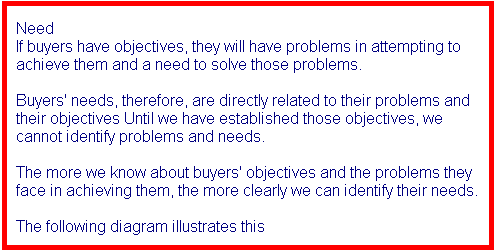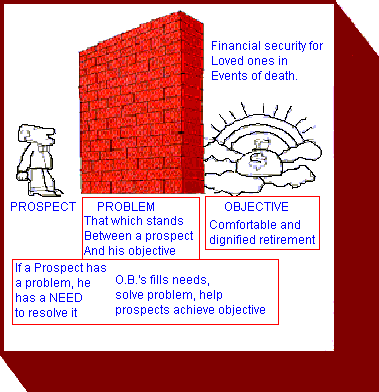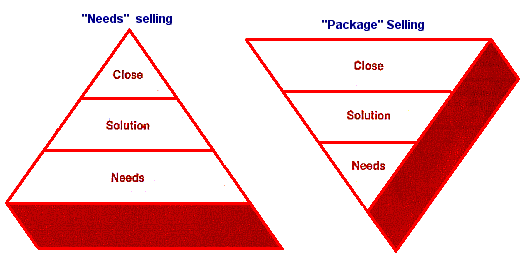|

Using reason motivation ideas to sell from the
prospect's point of view

For the moment, let's put aside the attention phase of the
buying motion. It will be covered later on in this module. We'll assume you have
and are holding favorable attention. First let's look at the interest phase,
your first opportunity to sell with a reason motivation idea.
What can you do for me?
You, the sales representative, have an important job to do in the interest
phase of the buying motion. You must offer to meet a specific need by
answering the prospect's big question, "What can you do for me?"
What would be need for one prospect would not be need for
another. For example, one prospect may need to accumulate cash for retirement. Another may
need income for his family throughout their lives should he not be present to provide it.
A third may need these, and in addition, immediate cash to provide for final expenses and
the education of the children in the event of death. Need depends on each prospect's
situation and what he or she wants to accomplish.

Let's go back to the example we used earlier. Suppose the sales person
who was selling us a suit said, "Since you travel so extensively, sir, you probably
find you must constantly have your suits cleaned and pressed. In addition to being
expensive and time-consuming, this shortens the life of the fabric. No need to concern
yourself with these things any longer. This suit holds its shape, doesn't wrinkle, and
feels comfortable the year round.
Perhaps you'd like to consider this model."
Chances are we would seriously consider buying the suit suggested. We
do so for two reasons. First, the sales person has taken the time to determine our
specific needs. Second, knowing these, he's answered the most important question on our
minds, "What can you do for me?" Note how the ideas appearing in
bold-face type provide an answer to this question. Perhaps you've noticed that these
ideas have several things in common. First, each idea promises some future benefit.
Second, the benefit can only be gained through the use of the product offered.
Owner benefit motivation idea
This particular kind of idea is our first reason motivation idea and is the only
one which answers the prospect's question, "What can you do for me?" This
idea is called the owner benefit motivation idea (abbreviated as o.b.). It
is defined as

The favorable result can be realized by the prospector those in whom the
prospect is interested-spouse, children, relatives, etc.
The prospect's need must always be identified and answered in the interest stage
of the buying motion. It can only be satisfied by a statement of owner benefit.
Examples of owner benefits:
∑ All immediate cash needs
will be provided for.
∑ Children will be able to get
the kind of education you want.
∑ Spouse won't have to seek means
of self-support.
∑ You can enjoy retirement years.
∑ Your estate will be protected
against shrinkage.
∑ You will have income in case of
disability.
TOP
You will note that in all examples the idea expressed as owner benefit is always
a promise of future gain through the use of the offering. The owner benefit has a
powerful effect on the prospect's interest.
Until you have identified your prospects' specific needs, selected the benefits that
satisfy them, and are certain that your prospects understand and want these benefits, they
have no reason for giving you more of their time.
While the concept of owner benefit is simple and natural,
selling the ob. way is sometimes difficult. This generally is due to the sales
representative's failure to recognize the prospect's viewpoint. It is also due to a
lifelong habit of self-centered thinking….thinking in terms of our own viewpoint. Had
the sales clerk in the clothing store performed as most sales people do-focusing first and
foremost on his own product, service or plan-he probably would have used such ideas as
"wool/polyester blend," "hard finish," "hand cut,"
"machine-stitched, ""integrated pattern," and so forth.
Obviously, it would take some imagination on our part, as buyers, to
relate these ideas to some specific benefits or to the satisfaction of our particular
needs. This example shows us that the sales person's viewpoint, more often than not, is
product-centered. It illustrates how prospects, when dealing with such a sales person,
must relate the seller's self-centered ideas to their needs. In briet they must sel ~
Truly professional sales representatives won't let this happen. They
won't gamble on their prospects' knowledge and ability to relate the product or service
being sold to their own needs and interests. Your problem, then, is to break the natural
habit of thinking in terms of yourself. Instead, think and sell from your prospects'
viewpoints. Identify their specific needs. Then tell them what your product or service can
do for them.
Often, when sales representatives first discover the power of selling
the o,b.'s way, they believe that merely naming o.b.'s in a sales presentation is good
selling. This is not so. O.b.'s have value only when they answer or meet a
prospect's specific need. For example, if a sales representative said to a prospect, 'You
will be certain that your children will get a college education" (ob.) only to
find that grandfather already setup a trust for that purpose, the ob. would be valueless.
Relating o.b.'s to specific needs, therefore, is essential. Think for a moment about the
word "need' which we often use so loosely.


TOP
Often, prospects cannot clearly state their objectives. Therefore, their conceptions of
their problems and their needs are fuzzy and shortsighted. This is why true professional
sales representatives spend as much time helping prospects crystallize their objectives
and problems as they do in offering to fill needs with the right solution.
Remember, the only thing you have to sell is an owner benefit. But,
to realize that ob., your prospects must give up something. it may be time. It certainly
will be money. And it also may be effort. Your prospects will be willing to give up none
of these if they do not perceive your o.b. as an ob., i.e., if they do not see it as a
solution to a problem that prevents them from attaining a meaningful objective.

You may recall from Professional Sales Development that too little
effort is put into analyzing a prospect's need, the determination of an appropriate
solution and a successful close becomes increasingly difficult. Package selling reverses
the steps of needs selling by predetermining a need, assuming a saleable solution and
turning the close into a battle of wits and stamina -a "win-lose" confrontation.
Contrast this to the "counselor" relationship that arises
from the needs selling technique of determining the prospect's needs, and presenting the
proper solution leading to a natural close. Through use of the needs selling technique you
become a problem solver. You develop vision, empathy and the desire to serve. Your clients
become partners in profit because the sales you make will be mutually beneficial. You plan
their insurance professionally and become a trusted financial advisor to them.

TOP
Where do owner benefits come from?
Look again at one of the salesman's second statements-"The
Consider this situation for a moment The Sloane's are thinking about
purchasing a dishwasher for their home, and Bill Wilson, the salesman, says "Notice
the chrome-plated hardware, baked enamel finish and the rubber-coated trays."
To the Sloane's these ideas would have little meaning in terms of
"What will this do for us?" But they would have to give Bill credit. He knows a
good bit about his product. However, in this situation, what is commonly accepted as
product knowledge hasn't helped Bill persuade the Sloane's to buy.
On the other hand, suppose Bill had said, "This dishwasher is easy
to clean (o.b.) because of the baked enamel finish and you don't have to worry about your
dishes being chipped (o.b.) because the trays are rubber-coated. Rust and corrosion are
never a problem (o.b.) with this machine because the parts are chrome-plated."
Why are these statements stronger than what the salesman said first? it
is because he is now gaining the buyer's interest through use of owner benefits provided
by elements of the product.

Look again at one of the salesman's second statement -- "The dishwasher
is easy to clean (o.b.) because of the baked enamel finish." Notice that the
baked enamel finish is the source of the owner benefit. II also makes a promise of
ease
of cleaning (o.b.)possible and believabre in the mind of the buyer.
Good quality motivation idea
This kind of idea, one that is the source of an owner benefit, is called good
quality (g.q.) and is our next reason motivation idea. It is defined as:

Each part of a product, service or plan is a good quality if it supplies
some owner benefit to the user. If it does not support an owner benefit, there
is no reason for it to be in the product, service or plan.
In the insurance business, o.b.'s may come to mind a lot easier
than g.q.'s. This is due to the fact that your principal g.q.'s are the
provisions of your policies. An explanation of those provisions comes out as an o.b. For
instance: A waiver of premiums benefit (g.q.) because it is a characteristic or part of
the policy) is virtually impossible to talk about without saying "this waives the
premiums" which is an o.b.
But, you have other g.q.'s in addition to the provisions of your
Sequence is important policies.
∑ Your Company
itself is a g.q.
∑ Its systems and
procedures (insofar as they affect your clients) are g.q.'s.
∑ You, yourself,
are a g.q. from which your clients derive o.b.'s.
Each and every resource of the Company is a g.q. to the extent that it
backs up o.b.'s to your clients and makes them believable.
The most commonly used g.q.'s in the insurance business, though, are
those related to policy provisions, and, for reasons mentioned above, these usually are
expressed as o.b.'s.
TOP
So far we have seen that the good quality motivation idea makes
owner benefits believable and possible. We know that "true product
knowledge" is complete understanding of the good qualities of a product,
service or plan and the owner benefits they produce. in order to gain
complete product knowledge, we must be able to identify as many good qualities of
our offering as possible along with the benefits they supply. Your analysis of good
qualities should go beyond those that are obvious in your product, service or plan.
In other words, expand your viewpoint to include all possible good qualities.
Consider your Company, its human and financial resources, its systems
and procedures. Consider, too, your own knowledge of your business. These are the sources
of your o.b.'s. You have a lot to sell.
The next step in gaining true product knowledge is to identify the
specific owner benefits that each g.q. provides. Until you can do this with all
of your good qualities, you don't really know your product.
In any sales presentation you make, the sequence of these two reason
motivation ideas, o.b. and g.q., is extremely important.
Remember, in the buying motion the prospect's selfish interest must
be brought into focus in order for the evaluation and decision to be favorable
Owner benefits generate such interest, and therefore, must be stated early in the
presentation. Leading with a good quality in the interest phase (Example: "We
have a plan" g.q.) forces your prospect to imagine results, and they won't
always be viewed as benefits. In fact you can count on it. In most cases, Fosses rather
than gains (o.b.) will be imagined. Your prospect's reaction to "We have a
plan" (g.q.) more than likely will be, "Oh, oh, here it comes." G.q.
selling is doing it the hard way. O.b. selling is the way to make more sales. It is
vital to the success of the sale, therefore, that you state o.b.'s first and then
support them with g.q.'s. To this we can only add that the o.b.'s you use be
related to clearly defined needs of your prospect.
TOP
Summary-Using reason motivation ideas to sell from the prospect's
point ot view
I. In the interest phase of the buying motion you must offer to meet a
specific need by answering the prospect's question, "What can you do for me?"
II. Your success as a sales representative depends upon your ability to
determine and meet your prospect's needs.
Ill. The owner benefit motivation idea is the only reason motivation
idea which answers the prospect's question, "What's in it for me?"
A. Its defined as: a favorable result which can be achieved through
the use of your product, service or plan.
B. The prospect's need can only be satisfied by a statement of owner
benefit.
1. Tho owner benefit is always a promise of future gain through the use of the
offering.
2. The owner benefit has a powerful effect on the prospect's
interest.
C. Owner benefits have value only when they answer apr05-pect's
specific need.
I. If buyers have objectives, they will have problems in attempting to achieve them and
a need to solve those problems.
2. Truly professional sales representatives spend as much time helping prospects
crystallize their objectives and problems as they do in offering to fil needs with the
right solutions.
TOP
IV. Where do owner benefits come from?
A Owner benefits are provided by elements of the product.
B. The ability to develop owner benefits from elements of the
product, service, or plan is the real meaning of product knowledge.
V. A good quality reason motivation idea is any characteristic or part
of a product, service or plan that provides the "user" with a favorable result
(o.b.).
A. Each part of a product, service or plan is a good quality if it
supplies some owner benefit to the user.
B. In the insurance business, you have other good qualities in
addition to policy provisions:
I. Your Company
2 Its systems and procedures
3 You, yourself
C. Expand your viewpoint to include all possible
good qualities.
B. Identify specific owner benefits that each good quality provides.
VI. In any sales presentation, the sequence of two reason motivation
ideas-owner benefit and good quality-is very important.
A. Owner benefits must be stated in the interest phase of the buying
motion in order for the evaluation and decision to be favorable.
B. Leading with a good quality forces your prospect to imagine results
which won't always be viewed as benefits.
C. G.q. selling is doing it the hard way. O.b. selling is the way
TOP
|